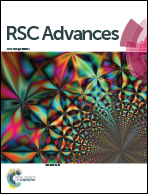UPLC simultaneous determination of empagliflozin, linagliptin and metformin
Abstract
The first UPLC method for simultaneous determination of empagliflozin, linagliptin and metformin hydrochloride in the different combinations of their pharmaceutical dosage forms was developed. Chromatographic separation was achieved on a Symmetry® Acclaim™ RSLC 120 C18 column (100 mm × 2.1 mm, 2.2 μm) applying isocratic elution based on potassium dihydrogen phosphate buffer pH (4)–methanol (50 : 50, v/v) as the mobile phase. The linearity, accuracy and precision were found to be acceptable over the concentration ranges of 1–32 μg mL−1, 0.5–16 μg mL−1 and 1–100 μg mL−1 for empagliflozin, linagliptin and metformin hydrochloride, respectively. All the variables were studied to optimize the chromatographic conditions. The optimized method was validated and proved to be suitable for the quality control of the mentioned drugs in their different pharmaceutical dosage forms.


 Please wait while we load your content...
Please wait while we load your content...